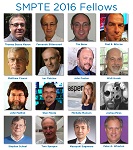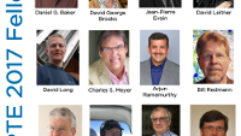
WHITE PLAINS, N.Y. — Aug. 29, 2016 —The Society of Motion Picture and Television Engineers(R) (SMPTE(R)), the organization whose standards work has supported a century of technological advances in entertainment technology, today announced that this year — the Society’s centennial year — it will elevate 16 industry leaders to the status of SMPTE Fellow. This honor is conferred on individuals who have, through their proficiency and contributions to the industry, attained an outstanding rank among members of the Society.
SMPTE 2016 Fellows
Fernando Bittencourt, CTO and General Director of Engineering at TV Globo
For 45 years Fernando Bittencourt has headed overall engineering operations and set the technology vision for TV Globo, the biggest TV Network in Latin America, covering 98 percent of the Brazilian national territory. He has built a distinguished career at TV Globo, and his many achievements over this time include serving as the SMPTE Governor for EMEA and Central and South America Region, a council member of the International Broadcasting Convention (IBC), the broadcast vice president of Brazilian Society of Television and Telecommunication Engineers (SET), and commissioner to the Upper House of the Brazilian Congress in TV, media, and telecommunication regulatory and technological matters. As chair of the Digital TV Group created by the Association of Brazilian Broadcasters (ABERT), Bittencourt also drove the studies and recommendation that led to the adoption of the modified Sistema Brasileiro de Televisão Digital (ISDB-T) standard in Brazil, called Brazilian Digital Television System (SBTVD), which is now in the process of final implementation.
Tim Borer, Lead Engineer at BBC Research and Development
Tim Borer is one of the inventors of the Alchemist motion compensated standards converter and is a co-developer of the BBC/Japan Broadcasting Corporation (NHK) Hybrid Log-Gamma HDR solution. As a lead engineer at British Broadcasting Corporation Research and Development (BBC R&D), he currently focuses on aspects of ultra-high-definition television (UHDTV) such as high-dynamic-range (HDR) and higher frame rates (HFR). Previously, Borer led the video compression team at BBC R&D that developed “Dirac” and the SMPTE VC-2 video compression standard. Before joining the BBC, he designed professional broadcasting equipment, including motion-compensated standards converters and compression equipment, for both Snell and Harris. Borer holds degrees in video processing, electronics, and physics. He is a Chartered Engineer (MIET) and is the inventor or co-inventor of 20 patents.
Paul E. Briscoe, Consultant at Televisionary Consulting
Paul E. Briscoe began his career as an engineer at CBC Television. Specializing in the emerging domains of digital television and computer-generated imagery (CGI), Briscoe helped design the Toronto Broadcasting Centre, an all-digital radio and TV production center utilizing the then-new serial digital interface (SDI) infrastructure, including the development of the custom routing switcher control system, all computer graphics facilities, distributed production resources, and overall facility systemization and timing. Today, he provides system, technology, design, and standards consultation. A creative and inventive technology and product designer, Briscoe has several patents granted and pending. He is a member of SMPTE and IEEE, participates in many SMPTE standards committees, and is a member of the board of managers and past chair of the SMPTE Toronto Section. Briscoe has delivered technical papers to conference and committee audiences including SMPTE, IEEE, VSF, AES, EBU, IRT, NAB and PBS. Over his career, he has developed and taught technology courses at several colleges.
Matthew Cowan, CTO at Entertainment Technology Canada Ltd.
Matthew Cowan specializes in matching human perception with design requirements for visual capture and display systems. His early career focused on developing high-performance display systems, where he pursued, in engineering terms, how to give a “film look” to a digitally projected image. As a principal with Entertainment Technology Consultants, he has brought this knowledge of image color and dynamics to cinema technology leaders such as Texas Instruments, IMAX, Christie Digital, and Kodak. Cowan has tackled the problem of developing a practical 3D system for digital theaters, resulting in RealD’s solution. Cowan’s current work is looking at the next generation of cinema performance, with extended color, brightness, and dynamic range. He has 18 issued and 25 patents pending in the area of image processing and 3D systems. He has chaired numerous standards committees in the field of digital cinema, 3D, and laser illumination, and is a regular speaker at industry conferences.
Ian Fletcher, CTO at Grass Valley, a Belden Brand
Ian Fletcher’s career began at the BBC, where he worked as a sound engineer before setting up his video production company. Fletcher grew increasingly interested in the potential of new low-cost microcomputers to bring innovative solutions to the broadcast industry. He formed OmniBus Systems, where as chief technology officer, Fletcher spearheaded many of the technological revolutions in the broadcast industry, including the transition from tape- to server-based systems, news automation, large-scale multichannel automation, and the groundbreaking, software-based playout system, iTX. Over the years, Fletcher has received many industry accolades, including the coveted Queen’s Award for Innovation. Following Omnibus’ acquisition by Miranda Technologies and Miranda’s subsequent acquisition by Belden and merger with Grass Valley, Fletcher has continued to drive the development of software systems, particularly in the emerging areas of cloud playout and virtualization. He holds two patents for video image identification and cloud-based playout.
John Footen, Global Head of the Broadcast Consulting Practice at Cognizant
John Footen is a global industry expert in business process management, service-oriented architecture (SOA), and the cloud, and he has been responsible for managing broad and complex media solutions projects for various media enterprises. As head of Cognizant’s broadcast consulting practice, Footen is responsible for business and technology consulting throughout the broadcast industry. He is a founding co-chair of the Framework for Interoperable Media Services (FIMS) and has chaired multiple SMPTE Technology Committees (TCs). He earned the SMPTE Workflow Systems Medal for pioneering the introduction of workflow-improving approaches such as SOA into the media industry, as well as his leadership in furthering the Society’s standards and education work. He holds degrees in computer science and film and television from New York University and is co-author of the book “The Service-Oriented Media Enterprise: SOA, BPM, and Web Services in Professional Media Systems.” He is a sought-after speaker and expert writer on software architecture and workflow issues.
Walt Husak, Director of Image Technologies at Dolby Laboratories Inc.
Walt Husak began his career carrying out video objective measurements and radio frequency (RF) multipath testing of high definition television (HDTV) systems proposed for the Advanced Television Systems Committee, Inc. (ATSC) standard. He worked on issues related to global HDTV deployments, including video compression, digital television RF transmission, and overcoming multipath signals in urban and rural environments. Husak joined Dolby in 2000 as a member of the chief technology officer’s office working on video compression and imaging systems for digital cinema and digital television. He has managed or executed visual quality tests for Digital Cinema Initiatives (DCI), ATSC, Dolby, and Moving Picture Experts Group (MPEG), with a current focus on HDR. Husak has authored articles and papers for major industry publications and holds several patents. He was also a member of two teams that received Emmy(R) Awards. Husak currently co-chairs the Joint Photographic Experts Group (JPEG) Requirements Group and is the chair of the USNB for JPEG.
John Mailhot, CTO of Networking and Infrastructure at Imagine Communications
John Mailhot has worked in the field of digital high-definition (HD) television systems since its North American inception in 1990. He began as part of the AT&T-Zenith team, responsible for system architecture and integration of the digital spectrum compatible high-definition television (DSC-HDTV) system prototype, and then served as technical lead for the Grand Alliance encoder at Lucent Technologies. He subsequently held engineering manager and general manager roles at Lucent Digital Video, Aastra Digital Video, and the Harris Broadcast Video Networking Group. Today, Mailhot is chief technology officer of the networking and infrastructure team at Imagine Communications. He has dual bachelor’s degrees in computer science and electrical engineering from the Massachusetts Institute of Technology (MIT).
Thomas Bause Mason, Director of Advanced Digital Media Technology for NBCUniversal
Thomas Bause Mason began his career in Cologne, Germany, as a computer programmer for automation software in the nuclear and automobile industries. Before his move to Los Angeles, Bause Mason worked at West German Television (WDR) and Cologne Broadcasting Center (CBC), where he led the quality control department. In Los Angeles, he became a postproduction consultant and then built and managed the encoding operations for Ascent Media. Joining NBCUniversal in 2005, he focused on emerging digital media technology, spending two years in London to support the company’s international business. In his current role, Bause Mason provides proof of concept and product evaluation within the engineering organization. He assists industry organizations in the development of standards, technical recommendations, and study group reports. Bause Mason holds several patents relating to watermarking, 3D, authentication, as well as metadata tagging and has a master’s degree equivalent in media technology.
Stan Moote, CTO at IABM
Stan Moote began his career in 1977 interning as a plant engineer for CFTO-TV in Toronto while obtaining his engineering degree from the University of Waterloo. In 1980 he co-founded Digi-tel and was responsible for the design and development of various innovative digital video products before bringing his many talents to Leitch in 1984. While holding vice president and chief technology officer positions at Leitch and Harris, Moote focused on workflow solutions, new technology, standardization, and interoperability on a global basis. He developed several patents, including scrambling systems, data monitoring, multiviewer, router processors, and internet protocol television (IPTV) systems. Moote was involved in the SMPTE Digital Video Standards Committee meetings creating CCIR-601, and, as a member of the VSF board of directors, continued his standardization work on video transport. He is an active participant of the National Academy of Television Arts & Sciences (NATAS) Technical Emmy(R) Committee and received the prodigious SMPTE Digital Processing Medal Award in 2015.
Michelle Munson, CEO and Co-founder of Aspera, an IBM Company
Michelle Munson began as a software engineer at research and start-up companies, including the IBM Almaden Research Center, before founding Aspera in 2004. She has dual bachelor of science degrees in electrical engineering and physics from Kansas State University (KSU), was a Goldwater Scholar for Achievement in Science and Mathematics, and later a Fulbright Scholar at Cambridge University, where she received a postgraduate diploma in computer science. Munson was the 2006 KSU College of Engineering Alumni Fellow, the youngest recipient ever, and has received national achievement awards from Glamour Magazine and USA Today. She is co-inventor of Aspera’s FASP(R) transport technology and is responsible for overseeing the company’s direction in collaboration with co-founder Serban Simu. Munson is a frequent speaker on technologies and trends in big data transport, cloud infrastructure, and mobile. She has won the IABM Woman of the Year, the TVNewsCheck Women in Technology Leadership Award, and is the Charles S. Schwartz Award designee for 2016 by the Hollywood Professional Association (HPA(R)).
Joshua Pines, Vice President of Imaging, Research and Development at Technicolor Production Services
Joshua Pines joined Technicolor after more than a decade at Industrial Light & Magic (ILM), where he supervised the company’s film scanning/recording department from its inception and worked extensively with both traditional and digital cinema technologies. He began his career by teaching film courses at The Cooper Union for the Advancement of Science and Art in New York, where he earlier earned his degree in electrical engineering. Pines began working in visual effects (VFX) at Mathematical Applications Graphics Group Inc. (MAGI) in 1982, at the tail end of its work on “Tron,” and continued to lead the computer graphics division at R/Greenberg Associates (R/GA) before supervising film effects and film recording at deGraf/Wahrman. Pines has earned two technical achievement awards from the Academy of Motion Picture Arts and Sciences (AMPAS), the Herbert Kalmus Award from SMPTE, and credits on numerous feature films.
Stephan Scheel, Senior Director, Media Workflow, at Public Broadcasting Service (PBS)
Stephan Scheel is senior director of media workflow for the Public Broadcasting Service (PBS) in Arlington, Virginia. Scheel began his broadcast career in 1966 at a transmitter site in western Nebraska before moving on to University of Nebraska television from 1968 to 1973. His work at PBS includes designing and implementing file-based workflows and automated quality control (QC) processes. Scheel has collaborated with the Advanced Media Workflow Association (AMWA), SMPTE, and multiple vendors to align PBS with new file formats and improve media processing. He has held various positions within PBS’s Operations and Engineering department for more than four decades. During those years, Scheel has assisted in formulating and administrating the technical evaluation of standards and processes at PBS. He has participated in the design and implementation of every evolution in PBS facilities since the first satellite system was deployed in 1978.
Tom Sprague, OTO at Museum of Broadcast Technology and CTO at National Boston LLC
Tom Sprague began his career at WMUR-TV in Manchester, New Hampshire, where he ultimately served as the station’s chief engineer. He later worked as a field service engineer and training instructor for RCA in Camden, New Jersey, and as an equipment planning engineer at ABC in New York. In the 1980s, Sprague developed a line of digital television equipment sold under his company, Imaging Systems Inc., and later in conjunction with Ampex and the British manufacturer Paltex. In 2007, he co-founded the Museum of Broadcast Technology Inc. in Woonsocket, Rhode Island, a 15,000-square-foot facility dedicated to the preservation and restoration of broadcast radio and television equipment. Sprague has been a SMPTE Member since 1976. He was the ABC representative to the SMPTE committees for the one-inch type B and type C recording formats.
Masayuki Sugawara, Executive Engineer at NEC Corporation
Masayuki Sugawara joined NHK in 1983. Since 1987, he has researched solid-state image sensors, HDTV cameras, and the UHDTV system at NHK Science & Technology Research Laboratories (STRL). Sugawara was an associate professor at the University of Electro-Communications, Tokyo, from 2000 to 2004. He has been attending International Telecommunications Union’s Radiocommunication Sector (ITU-R) Study Group 6 (SG 6) meetings since 2004 and been active in the working parties that deal with program production and UHDTV. Sugawara retired from NHK and moved to NEC Corporation in 2015. He is a member of SMPTE, the Institute of Electronics, Information and Communication Engineers (IEICE), and the Institute of Image Information and Television Engineers (ITE). Sugawara is currently the vice president of the ITE and the chair of the Digital Broadcasting Experts Group (DiBEG) in Association of Radio Industries and Businesses (ARIB). He received a Bachelor of Science and Master of Science in electric communication engineering and a Ph.D. in electronic engineering from Tohoku University, Sendai, Japan.
Peter G. Wharton, Vice President for Technology and Business Development at BroadStream
Peter Wharton is responsible for the technical and strategic direction of BroadStream. Prior to BroadStream, Wharton was at Grass Valley, formerly Miranda Technologies, where he held roles in sales, business development, strategic account management, product management, and engineering. He has played a role in the centralization initiatives of station groups, as well as the design and implementation of specialty channel and TV network playout facilities. Before joining Grass Valley, Wharton held engineering roles with PanAmSat, Fox News Channel, and ABC Radio and Television Networks. He currently serves as the secretary-treasurer on the SMPTE Board of Governors, and he previously served as the Eastern Regional Governor and as a manager of the SMPTE Washington, D.C. Section, where he has been the producer for the Section’s annual “Bits by the Bay,” a two-day technology conference, since the 1990s.
New SMPTE Fellows will be recognized during the SMPTE Honors & Awards ceremony on Monday, Oct. 24, and formally elevated on Tuesday, Oct. 25, during the Fellows Luncheon, held in conjunction with the SMPTE 2016 Annual Technical Conference & Exhibition (SMPTE 2016) at the Hollywood and Highland Center in Los Angeles. The Fellows Luncheon is open exclusively to SMPTE Fellows and Life Fellows, and SMPTE Fellows wishing to attend must select this ticket option when submitting their SMPTE 2016 conference registration.
Further information about SMPTE 2016 is available at www.smpte2016.org.
# # #
About the Society of Motion Picture and Television Engineers(R) (SMPTE(R))
For the past 100 years, the people of the Society of Motion Pictures and Television Engineers (SMPTE, pronounced “simp-tee”) have sorted out the details of many significant advances in entertainment technology, from the introduction of “talkies” and color television to HD and UHD (4K, 8K) TV. Since its founding in 1916, the Society has earned an Oscar(R) and multiple Emmy(R) Awards for its work in advancing moving-imagery education and engineering across the communications, technology, media, and entertainment industries. The Society has developed thousands of standards, recommended practices, and engineering guidelines, more than 800 of which are currently in force.
SMPTE’s global membership today includes 7,000 members, who are motion-imaging executives, engineers, creative and technology professionals, researchers, scientists, educators, and students. A partnership with the Hollywood Professional Association (HPA(R)) connects SMPTE and its membership with the professional community of businesses and individuals who provide the expertise, support, tools, and infrastructure for the creation and finishing of motion pictures, television programs, commercials, digital media, and other dynamic media content. Information on joining SMPTE is available at www.smpte.org/join.
Photo Link: www.wallstcom.com/SMPTE/SMPTE-2016-Fellows.jpg
Photo Caption: SMPTE 2016 Fellows
Share it on Twitter: https://twitter.com/intent/tweet?text=.@smpteconnect Elevates 16 Motion-Imaging Technology Industry Leaders to Fellow Status – http://goo.gl/3cpZSs










